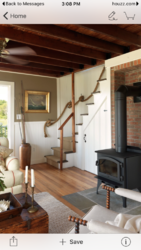- Jan 11, 2006
- 91
Hi there:
I am remodeling my kitchen area to include a wood stove and am trying to minimize how far the stove sticks into the room, since the kitchen is not huge.
1. The wall behind the stove is the wall that encloses the chimney. Currently there is only wood framing in place.
2. I want the back wall to be brick veneer.
I am having a difficult time coming up with a protected wall that is thin and doesn't have exposed sheet metal. Also, I am having a tough time figuring out how to incorporate the 1" of ventillation space at the top and bottom of the wall, and my wife doesn't want to see it at the top.
My initial thought was to install Micore board over the wood framing then install the masonry veneer on top, but that doesn't seem to fit any of the protected wall configurations in NFPA 211. They all seem to require a ventilation space.
There is one option that doesn't require ventilation, which results in some reduction, but only gets 9" instead of 6" in back. Would installing Roxul fire safing batts between the studs and Micore over the top work for that? Or does the mineral fiber need to be on top of the framing?
I've attached a picture with the installation we are trying to achieve.
Any suggestions are appreciated, including attractive ventilation solutions at top and bottom.
Thanks,
John
I am remodeling my kitchen area to include a wood stove and am trying to minimize how far the stove sticks into the room, since the kitchen is not huge.
1. The wall behind the stove is the wall that encloses the chimney. Currently there is only wood framing in place.
2. I want the back wall to be brick veneer.
I am having a difficult time coming up with a protected wall that is thin and doesn't have exposed sheet metal. Also, I am having a tough time figuring out how to incorporate the 1" of ventillation space at the top and bottom of the wall, and my wife doesn't want to see it at the top.
My initial thought was to install Micore board over the wood framing then install the masonry veneer on top, but that doesn't seem to fit any of the protected wall configurations in NFPA 211. They all seem to require a ventilation space.
There is one option that doesn't require ventilation, which results in some reduction, but only gets 9" instead of 6" in back. Would installing Roxul fire safing batts between the studs and Micore over the top work for that? Or does the mineral fiber need to be on top of the framing?
I've attached a picture with the installation we are trying to achieve.
Any suggestions are appreciated, including attractive ventilation solutions at top and bottom.
Thanks,
John


